An Afternoon At South Arm Pool Brings Memories Of A Quiet Past
Saturday, July 04, 2009
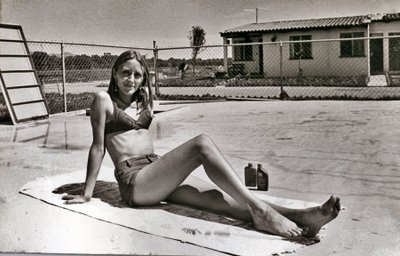 After lunch of homemade pizza Rosemary and I took the two girls to the South Arm Pool in Richmond. The pool has a couple of water slides. Rebecca and Lauren were looking forward to it. Rebecca has passed her Aquaquest 9 and her instructor says that Rebecca has grace no matter what swimming stroke she does. Lauren passed Aquaquest 1 and still insists on using a floating vest in the water. But both love being in the water. As I watched the crowds, some were playing Frisbee, others were screaming in the water and young girls in bikinis were experimenting with getting glances from young boys. I could not understand how we had been persuaded to come to the place. But there was a comforting familiarity which I cold not pin down until we were driving home. Sometime in the early 70s while living in Mexico City we discovered a way of avoiding swimming pool crowds on hot summer days. We would drive with our young daughters Ale and Hilary to a KOA (Kampgrounds of America) that was not too far (about an hour away) from our house. We would check in and pay for a day’s stay. This gave us access to their swimming pool which we always enjoyed in what now really seems like a luxurious privacy. In the pictures you can see Rosemary, about 28, and Ale, 5, on the swing. There were no water slides but this was amply compensated by the stark and peaceful quiet of the Mexican sierra. To be fair, with the advent of iPods, there were next to no loud ghetto blasters today at South Arm Pool. While drying in the sun I was hit several times in the head by errant Frisbees. Frisbees have changed. These were the size of a pizza dish. 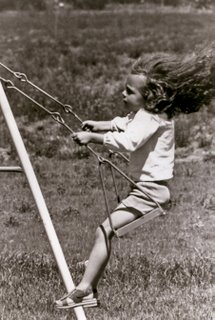 While attempting to swim in a pool that seems to have no deep end ( public parks in no-fun-let’s-always-be-safe Vancouver have eliminated deep ends, slides, and have now banned mothers from taking their children down the water slides together) I counted the hundreds of young children there. I wondered (I inherited this from my Tío Luís Miranda who hated beaches because he said sand got into his shoes) how many were too lazy to go to the bathroom in the designated location? Yet sacrifices have to me made and in the end it was all worth it as I watched Rebecca and Lauren laugh. I even spied the usually somber Rosemary smiling here and there.
Falstaff In The Focative Case
Friday, July 03, 2009

For once Rebecca, Rosemary and I agree on something about the garden. The three of us have gone nuts for old roses that are red or crimson. We are particularly into the once-blooming Gallicas (including our fave ‘Charles de Mills’) as they have the peculiarity of fading into beautiful purples, gray blues and sometimes a metallic blue. So when we find roses that fit all those requirements (including, of course a strong old rose scent) plus the plant in question is remontant (Rebecca would tell you that it means that the rose bush in question re-blooms throughout the summer) we are in rose heaven. We already have in the garden David Austin’s beautiful ‘William Shakespeare’. This rose was supposed to be a dud so Austin took it out of the market and introduced an improved version with the unpoetic name of ‘William Shakespeare 2000’. The fact is that with some tender and loving care my ‘William Shakespeare’ is doing just fine right next to a new plant (new in our garden this year) ‘William Shakespeare 2000’.
It was last year at the Vancouver Rose Society’s rose show at VanDusen that both Rebecca and Rosemary spotted a English Rose that somehow had escaped my notice. It was a beautiful crimson ‘Falstaff’. This year I ordered a plant and plunked it into the garden. Note the scan of one of the blooms that I cut this afternoon.
This spring Rebecca told me she, too, wanted ‘Falstaff’. Her father had told her that unless she took care of her plants she was not to have any more roses in her plant-in-pot garden. I did not pursue the matter and now it seems that Rebecca has developed a renewed interest in taking care of her plants and she is most proud of them. One day Rebecca went to Southlands with her other grandmother and spotted ‘Falstaff’. Rebecca checked her pocket and she needed some more money to buy her plant. I suspect that her grandmother saw this as a child’s passing fancy so she did not add to Rebecca’s money pot and the rose was not purchased. She must have made a loud fuss on how fantastic the plant was because when I returned the next day to buy it for her it had been sold.
There is one consolation here for Rebecca and that is that Rosa ‘Charles de Mills’ is a rose that sends underground runners. My ‘Charles de Mills’ has two ancillary plants. One of them is in bloom with many flowers. Rebecca knows that when the plant is semi dormant in the fall I will dig it out and the plant will be hers.
As I brought in ‘Falstaff’ to scan it I thought of one of my favourite books by Anthony Burgess. Burgess seems to be an author who was underappreciated when he was alive. Perhaps it had to do with the fact that he was a prolific author. The book in question is called 99 Novels – The Best in English Since 1939. It ends with Norman Mailer’s 1983 Ancient Evenings and it starts with Henry Green’s Party Going.
The bringing in of ‘Falstaff’ brought to mind 1976 as Burgess lists for that year, Robert Nye’s Falstaff.
This is what he writes about the book which I will have to now find at the library.
François Rabelais presents characters, even though some of them are giants, and events, even though many are implausible, and so may be considered a novelist. Joyce was influenced by him, and in many post-Joycean novelists the urge to expand fiction Joyceanly is really a desire to return to Rabelais. Robert Nye has stolen Shakespeare’s Falstaff, unrelating him to the historical original, and, as it were, unbuttoned him. He becomes her more than a witty exemplar of gorging and philosophical cowardice; he is turned into a god of fertility. A chapter entitled “About Sir John Falstaff’s Prick” is wholly Rabelaisian with its bawdy catalogue, though Rabelais would have gone much further. However much we long to be back Pantagruel and Panurge, we cannot lose all our inhibitions. Nye is occasionally facetious - “Buckram,” Falstaff says to Hal, “becomes you. It goes with your eyes” - but on the whole he combines, very successfully, the forward drive of modern fiction with the wordy divagations of a more monkish tradition. His Falstaff cannot be greater than Shakespeare’s, but the whole sprawling portrait is a relevant gloss on Shakespeare as well as a restoration of Falstaff to his true historical context (Shakespeare’s Falstaff is post-Reformation sceptic; Nye’s is a backsliding Catholic) and the erotic candour is of our own time.
The lovely focative sucking over, just this side of emission, she’d let my engine out of her spiced trap – (Mrs Nightwork was a great one for eating garlic and cloves.) Then she’d press my prick to her cheek, which was usually cool as cream. She had a trick of fluttering her eyelashes upon the delicate skin just below the head, where the foreskin puckers, which I find delicious…
This book was a bold venture and an indication of what the novel can do when it frees itself from the constraints of the Jamesian tradition.
----------------------------------------------------------------------------------------------------------------------------------
As for those who may want to explore the meaning of the word focative:
The Focative Case
Shakespeare, The Merry Wives of Windsor, IV.1.42-46:
Sir Hugh Evans:
What is the focative case, William?
William Page:
O,—vocativo, O.
Sir Hugh Evans:
Remember, William; focative is caret.
Mistress Quickly:
And that's a good root.
Focative (a pun on the f- word), caret (i.e. carrot = membrum virile), and root (membrum virile), but also in O, which he connected with ring and circle (all three to him signifying pudendum muliebre).
I leave it to any of my blog readers to pursue pudendum muliebre. And, yes, there is a David Austin English Rose called 'Mistress Quickly'.
Alain Blanchard Waits And Lisa Poses
Thursday, July 02, 2009
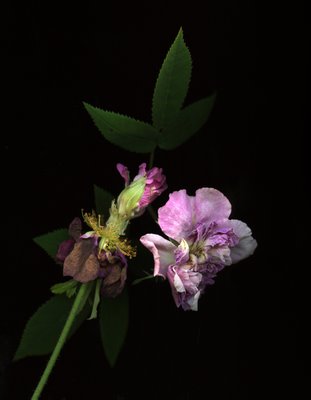
I first photographed the Vietnamese/Canadian Lisa Ha in June 2001, below, right. I then photographed her in Feb 2004. Today she posed for me in my studio. I asked her how old she was. She told me she was 33. One of the few fringe benefits of my profession is to photograph people over and over and be able to watch gentle (in the case of Lisa Ha) march of time. Perhaps I will photograph her a few more times before I hang up my cable release.
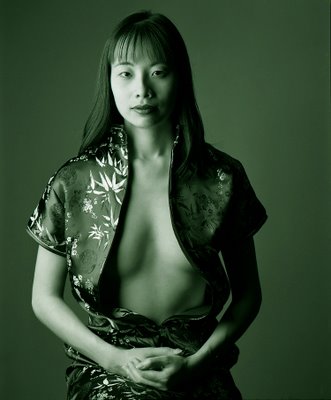
Unfortunately few women will allow themselves to be photographed beyond a certain age. I know I cannot approach a woman and tell her, “I am fascinated by the beautiful over the top decay of my garden in the fall. How would you like to pose for me?” I would receive, at the very least, a slap. And yet there is beauty in decay.
As I left for Texas on June 10 my mottled roses Rosa ‘Alain Blanchard’ and Rosa ‘Soleil Brillant’ were about to bloom. I felt sad that I would not see them in their prime. The fact is that when I returned June 18 they were going strong. Today I have cut off what is left of Alain Blanchard and I show here (the first one is from today) with two other images I took of her June 20, 2007. At her best Alain Blanchard has these spots on her petals. People who don’t know think that somehow this Gallica rose has suffered rain damage. But in fact a few of us appreciate the odd beauty of the marbled look. And a few of us also appreciate the beauty of over the top decay.
Oh Canada!
Wednesday, July 01, 2009
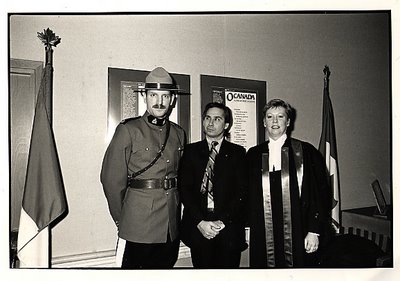 When I met Rosemary in Mexico City in 1968 I knew nothing of Canadians. In fact I used to think Canadians as “non-Americans”. The few I had met before Rosemary, were always correcting people and saying, “I am not an American, I am Canadian.” It seemed to me that Canadians were quite sure of what they weren’t. From Rosemary I learned to pronounce Quebec as Kebek and she had the quaint custom of saying “When I was in grade 9...” To my ears it sounded odd. Rosemary made me aware of Pierre Trudeau and that he was sexy even though the only other sexy Canadian I have ever met was Rosemary. I liked Rosemary in particular because of her precise English that did not sound American. It was almost a British English. My other knowledge of Canada was listening to my Grandmother Lolita tell me how in the late 20s they had taken a Japanese ship from Manila to a place that had mountains and tall trees. She pronounced the place “bancoober”. She told me of a huge train station (the CP Station) where she, my mother, her son Antonio and the other very young daughter Dolly had taken a train to Montreal and from there another to New York City. When I had met Rosemary I had a confused sense of national identity. I had gone to do my military service in Argentina and a moment of tearful patriotism when I had sworn allegiance (with thousands of other sailors) soon became one of disappointment and cynicism. I had been ordered to participate in a coup where the armed forces removed our legally elected president. In Mexico, in 1968 there had been a massacre of students at Tlatelolco. I talked like a Mexican but I did not feel like one. If anything my four years in a Texas Catholic boarding school had left its mark and I felt quite American. Like most Argentines I wore Levis and only wore button down shirts. I only listened to 60s American jazz and read only in English. Most of the books were by American authors. When we arrived in Canada in 1975 with our two daughters my first confusion was running into Mexicans who did not seem to understand my Spanish. Rosemary told me that these “Mexicans” were really Native Canadians. It was then that I realized that the old dictum that had been drummed into me at school about the red Indian and the yellow race of the Orient was all a sham. About 15 years ago I learned to dance the Argentine tango and I made friends with an Argentine couple Juan Manuel Sanchez and Nora Patrich. We would “matear” or drink mate almost every day. I began to read in Spanish. Suddenly I had a deep nostalgia for Argentina. I returned a couple of times but somehow I didn’t feel I fit there. I felt like a hybrid. I was a bit of everything. I was an everything that did not add up to anything. I was a landlubber Edward Everett Hale, The Man Without A Country. I had to become a Vancouverite before I could be a Canadian. That happened some years ago when I participated in a photographic show of architecture of our city. It was sponsored by the UBC School of Architecture which had opened a city branch by the Dominion Building. I looked at my pictures on the wall. They were up there with pioneers of such as Otto Landauer and Leonard Frank. These two men had photographed Vancouver from its inception. I was up there, too! This had to be my city. I left the show with the excitement that after almost 28 years in Vancouver (the show may have been about 11 years ago) I was no longer a tourist. I was from here. Canada rapidly adopted me without much fuss and too much paper work. Canada made me feel at home and fed me the addictive drug that is efficiency, 110 volts that are mostly unwavering and comforted me with the realization that I could lose my driver’s license but be able to get a replacement in minutes with no fuss. I took it for granted that the gas I put in my car was not diluted with water and except for the few times I was caught speeding I never felt and fear about being stopped by a cop. And every year, year after year I received and have received all 12 issues of the National Geographic. Except for the odd postal strike, the mail works! I feel nostalgia for Argentina and I feel nostalgia for the colours, the heat and the ancient churches of Mexico. But what I feel for Canada seems to be more serene. It is a calming realization that I live where I belong and I belong here where I live. Photo above by Robert Blake.
The Bastard Does Not Soar - He Sinks
Tuesday, June 30, 2009
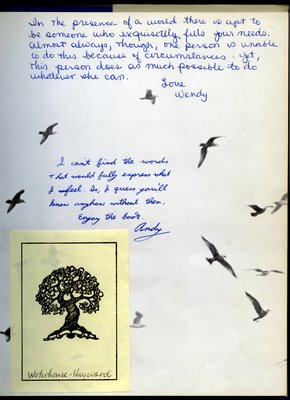 Students are much in my thoughts these days. Schools have changed or at least the ones where I teach have. Gone are the days when you respected a teacher because of age or erudition. It was sometime around 1972 when I had a pair of students who are possibly the best I ever had. They were both in the 9th grade (let's be Canadian and make that grade 9)in a high school in Mexico City. One was a young girl called Wendy Shanken the other a young man born in Switzerland called Andy Broennimann. Andy came to Vancouver in the late 70s to study at UBC. When he first arrived I told him if he planned to cycle in the winter that he needed to buy chains for his bicycle tires. In his wonderful naïve youth he did go to a bicycle shop to enquire about them! Later on he graduated to a motorcycle and he would take my daughter Ale who was around 10 for thrilling rides up the hill of Springer Avenue in Burnaby where we lived. He left Vancouver and a few years later he sent me a postcard from Cairo. He vanished after that. Wendy showed up in Vancouver perhaps some 10 years ago. She was organizing conferences. She lived with her husband in a small town near Montreal. A couple of years ago she sent me an e-mail and told me how she was traveling for her job all over the world. She named a string of countries in Africa I had never heard of. I became annoyed when she said, “I love to travel and to study different cultures.” It struck me sort of like Barbra Streisand loving people who love people. In another communication from her I decided to reply making believe I was my wife Rosemary. “Rosemary” informed Wendy of the sad occasion of her husband's recent death. It had been sudden. Wendy answered with a poignant letter of condolence and how I had somehow been a part of her life as a teacher. I responded with a statement that my death was a bit premature. Wendy answered, “You bastard.” I have never heard from her again. Today I reached for my copy of Jonathan Livingston Seagull by Richard Bach. Back in 1972 I had read the story to my 9th graders using a library edition. I had the class mesmerized with the idea that one could will hard enough and be able to soar. When the term ended Andy and Wendy gave me my own copy and reproduced here is their dedication. It seems now that the last paragraph of the little book might appropriately convey how I feel about students and that perhaps I should give the unruly bunch I face these days more of a chance. 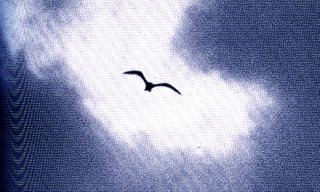 And though he tried to look properly severe for his students, Fletcher Seagull suddenly saw them all as they really were, just for a moment, and he more than liked, he loved what it was he saw. No limits, Jonathan? he thought, and he smiled. His race to learn had begun. And though he tried to look properly severe for his students, Fletcher Seagull suddenly saw them all as they really were, just for a moment, and he more than liked, he loved what it was he saw. No limits, Jonathan? he thought, and he smiled. His race to learn had begun.Jonathan Livingston Seagull Richard Bach
Death For Lunch
Monday, June 29, 2009

Rebecca arrived on Saturday with her new Bikini and told me, “Let’s go swimming today. I want to use my new bathing suit.” I told her that it wasn’t possible as a friend was coming in the afternoon for a chat in the garden and I had already made the commitment. Rebecca insisted, “Can’t you do it just for me?” I explained that my friend was sort of doing me a favour so I could not just think of her.
I decided to tell her some truths.
Rebecca, the man who is coming is Charles Campbell. He used to be an editor at the Georgia Straight and he gave me tons of work when he was there. He left for the Vancouver Sun and started a new Thursday magazine called Queue. With Queue he created a page called Rear Window in which he had me in mind. On that page I would use a picture that I had taken in the past that might have some relevance to the present. I wrote many Rear Windows.
One day Charles came to the house with a special request. He wanted me to take his portrait. He had learned that he had a malignant tumour in his head and that the only way they could reach it was through a dangerous operation involving either accessing it through his palate or through one of his eyes. Not only was his life in danger but should he survive it he would either lose feeling in most of his mouth and or lose one of his eyes. There was finality in the portrait I took of Charles. This one is the only one where he smiled as nicely as he could and somehow even managed to avoid his trademark crooked smile. Jokingly (perhaps to control a fear anybody in his shoes would have had) he told me, “I want you to photograph me so I can remember myself when I was handsome. Who knows what I will look like after the operation."
Rebecca instantly forgot about her swimming and wanted to immediately look at the portraits. “What does he look like now?” She also reminded me that she had met Charles and knew his wife and daughter. I had forgotten that Rebeccca had met the Campbells at a party of a mutual friend of ours.
Charles arrived just in time for a simple lunch of baked beans with melted cheese on top. We had that and my iced tea. At the table Rebecca grilled Charles. At one point Charles mentioned how an aunt of his had had a similar operation and that she had not been as lucky as he had been. She had lost an eye and wore an eye patch. At the dinner table Charles explained with glee a trick his aunt plays on friends. She removes her eye patch and inserts a finger in her mouth and then makes it stick out from her empty eye socket. At that point I think that Charles made a new friend in Rebecca.
Someday I will have to explain to Rebecca that at least half of my extensive files of celebrity portraits is due in part to the golden age of the print media in Vancouver. In that golden age actors, directors, bands and singers from abroad came to Vancouver and granted interviews to promote what they did. Charles and his Georgia Straight would dispatch me to photograph them.
This is not something that I can ever forget nor can I ever thank enough the man who escaped death. I think that my friend John Lekich may have put it best when he may have sweetly told me, “I am sure Charles will make it. After all if he dies, who is going to give us work?”
Rebecca is urging me to photograph Charles again. She wants to make sure I get that indentation near his cheek close to the place where the surgeon peeled Charles’ face back. Luckily as I think back to Saturday’s table conversation I am thankful they were only beans.
A Time Traveler
Sunday, June 28, 2009
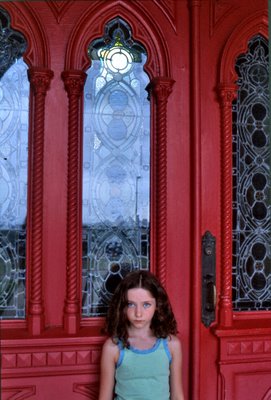 In July 2007 Rebecca Stewart, my granddaughter stood by the big red door of the Gothic revival structure that was the main building of my St. Ed’s High School. A few weeks ago during an electrical storm I moved one of the benches there and placed it right next to where Rebecca had stood. I watched the storm and heard the thunder while gazing north at the Austin skyline, the view that you can see here in back of Rebecca. A lighting bolt hit beyond the soccer field and it sparked down a tree. My company was a little white frog. As I watched the little frog wait for stray bugs I thought of the complex mechanism of time. I could imagine the taxi that may have brought me from the Greyhound bus station on my return on a Sunday night from my Christmas vacation at home in Nueva Rosita, Coahuila. Even by grade 12 I still missed my home and my mother on that night. The lugubrious and dark Gothic structure had not helped dispell my depression. But the sound of the loud morning bell in the morning; it shook us into instant alertness, never gave me time to think back and my melancholy would fade as we prepared for our breakfast and our first class of the day.  As I rested my head against the big red door I thought of Rebecca and how I had had no inkling of her existence in the future as I had come up the stairs with my suitcase on route to my dorm. Yet I had photographed her by that door 46 years later and I could feel her presence as strongly as I had that taxi. Rosemary had also been with me that July in 2007 and that felt as unlikely. And here I was sitting on the bench leaning my head on the big red door missing them both.  It would seem that time appears to be linear and irreversible when we are young and our future is before us. From my vantage point on that bench with my frog companion, in the time and space of that evening, time was flowing back and forth and perhaps even sideways. I was a time traveler.
|




















